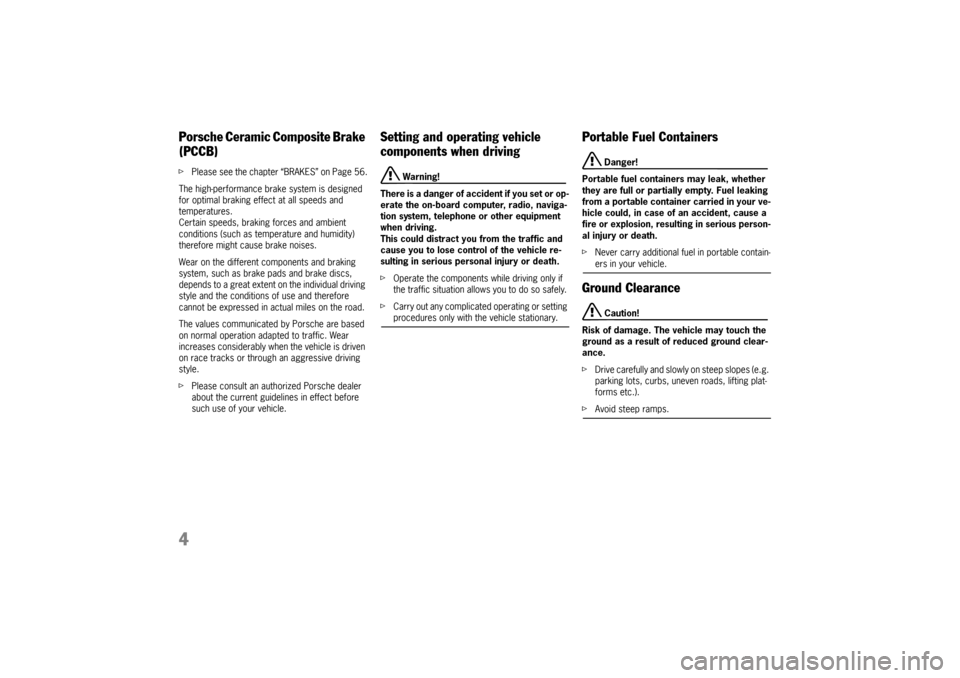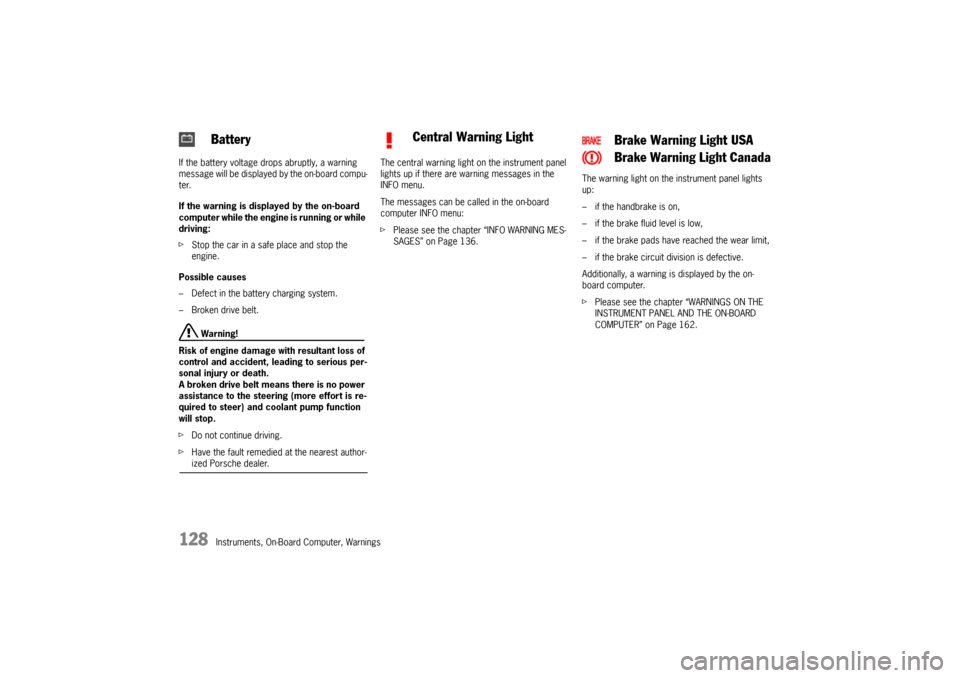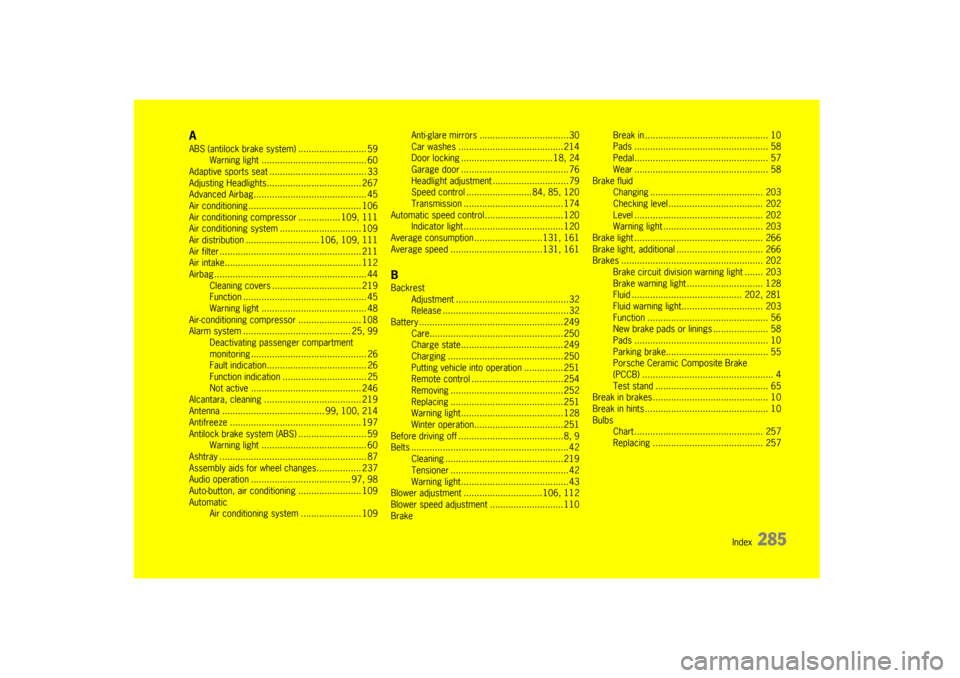brake pads PORSCHE BOXSTER S 2010 2.G Owners Manual
[x] Cancel search | Manufacturer: PORSCHE, Model Year: 2010, Model line: BOXSTER S, Model: PORSCHE BOXSTER S 2010 2.GPages: 294, PDF Size: 6.89 MB
Page 6 of 294

4Porsche Ceramic Composite Brake
(PCCB)fPlease see the chapter “BRAKES” on Page 56.
The high-performance brake system is designed
for optimal braking effect at all speeds and
temperatures.
Certain speeds, braking forces and ambient
conditions (such as temperature and humidity)
therefore might cause brake noises.
Wear on the different components and braking
system, such as brake pads and brake discs,
depends to a great extent on the individual driving
style and the conditions of use and therefore
cannot be expressed in actual miles on the road.
The values communicated by Porsche are based
on normal operation adapted to traffic. Wear
increases considerably when the vehicle is driven
on race tracks or through an aggressive driving
style.
f Please consult an authorized Porsche dealer
about the current guidelines in effect before
such use of your vehicle.
Setting and operating vehicle
components when driving
Warning!
There is a danger of acci dent if you set or op-
erate the on-board comp uter, radio, naviga-
tion system, telephone or other equipment
when driving.
This could distract you from the traffic and
cause you to lose control of the vehicle re-
sulting in serious personal injury or death.
f Operate the components while driving only if
the traffic situation allows you to do so safely.
f Carry out any complicated operating or setting procedures only with the vehicle stationary.
Portable Fuel Containers
Danger!
Portable fuel containers may leak, whether
they are full or partially empty. Fuel leaking
from a portable container carried in your ve-
hicle could, in case of an accident, cause a
fire or explosion, resulting in serious person-
al injury or death.
f Never carry additional fuel in portable contain-ers in your vehicle.
Ground Clearance
Caution!
Risk of damage. The vehicle may touch the
ground as a result of reduced ground clear-
ance.
f Drive carefully and slowly on steep slopes (e.g.
parking lots, curbs, uneven roads, lifting plat-
forms etc.).
fAvoid steep ramps.
Page 12 of 294

10
Before driving off...
Break in hints for the first
2,000 miles/3,000 kilometers The following tips will be helpful in obtaining opti-
mum performance from your new Porsche.
Despite the most modern, high-precision manufac-
turing methods, the moving parts must still wear
in with each other. This we aring-in occurs mainly in
the first 2,000 miles/3,000 kilometers.Therefore: f Preferably take longer trips.
f Avoid frequent cold starts with short-distance
driving whenever possible.
f Avoid full throttle starts and abrupt stops.
f Do not exceed maximum engine speed of
4,200 rpm (revolutions per minute).
f Do not run a cold engine at high rpm either in
Neutral or in gear.
f Do not let the engine labor, especially when
driving uphill. Shift to the next lower gear in
time (use the most favorable rpm range).
f Never lug the engine in high gear at low
speeds. This rule applies at all times, not just
during the break-in period. f
Do not participate in motor racing events,
sports driving schools, etc. during the first
2,000 miles/3,000 kilometers.
There may be a slight stiffness in the steering,
gear-shifting or other controls during the break-in
period which will gradually disappear.
Break in brake pads and brake discsNew brake pads and discs ha ve to be “broken in”,
and therefore only attain optimal friction when the
car has covered several hundred miles or km.
The slightly reduced braking ability must be com-
pensated for by pressing the brake pedal harder.
This also applies whenev er the brake pads and
brake discs are replaced. New tires New tires do not have maximum traction. They
tend to be slippery.
f Break in new tires by driving at moderate
speeds during the first 60 to 120 miles/100 to
200 km. Longer braking distances must be an-
ticipated.
Engine oil and fuel consumption During the break-in peri od oil and fuel consump-
tion may be higher than normal.
As always, the rate of oil consumption depends on
the quality and viscosity of oil, the speed at which
the engine is operated, the climate and road con-
ditions, as well as the amount of dilution and oxi-
dation of the lubricant.
f Make a habit of checking engine oil with every
refueling, add if necessary.
Page 60 of 294

58
Operation, Safety
Brake booster The brake booster assists braking only when
the engine is running.
When the car is moving while the engine is not run-
ning, or if the brake boos ter is defective, more
pressure on the brake pedal is required to bring
the car to a stop.
If this happens, ABS and PSM will also not oper-
ate.
Moisture or road salt on brakes affects braking.
Brakes will dry after a fe w cautious brake applica-
tions.
Warning!
Risk of an accident, resulting in serious per-
sonal injury or death.
Driving through water may reduce the trac-
tion.
Moisture on brakes from road water, car
wash, or coating of road salt may affect
braking efficiency.
f Cautiously apply brakes to test brakes after ex-posure to road water, etc.
Brake wear Your car has excellent brakes, but they are still
subject to wear. The rate at which they wear de-
pends on how the brakes are used.
f Have the brake system inspected at the
intervals recommended in your Maintenance
Booklet.
Brake system warning light
You can check the functionality of the brake
system warning light by switching the ignition to
the "On" position and verifying that the warning
light illuminates.
If the warning lights in the instrument panel and on-
board computer stay on when the engine is run-
ning or come on while driv ing, the brake pads are
worn excessively.
f Do not continue to operate the vehicle.
Have your authorized Porsche dealer inspect
or replace the brake pads.
Brake pads and brake discsWear on the brake pads and brake discs depends
to a great extent on the driving style and the con-
ditions of use and therefore cannot be expressed
in actual miles on the road.
The high-performance brake system is designed
for optimal braking effect at all speeds and tem-
peratures.
Certain speeds, braking forces and ambient
conditions (such as temperature and humidity)
therefore might cause “brake noises”.
New brake pads or linings
New brake pads and brake discs have to be “bro-
ken in”, and therefore only attain optimal friction
when the car has covered several hundred miles
or km.
The slightly reduced braking ability must be com-
pensated for by pressing the brake pedal harder.
This also applies whenever the brake pads and
brake discs are replaced.
Warning light USA
Warning light Canada
Page 65 of 294

Operation, Safety
63
Porsche Stability Management
(PSM)PSM is an active control system for stabilization of
the vehicle approaching the performance limits of
driving maneuvers.
Warning!
Risk of an accident, resulting in serious per-
sonal injury or death.
The increased control that is provided should
not induce you to take greater risks with your
safety. The limits dictated by the laws of
physics cannot be overcome, even with PSM.
The risk of accidents due to inappropriate
speed cannot be reduced, even by PSM.
The driver bears the responsibility for all
driving maneuvers.
f Adapt your driving style to the prevailing road
and weather conditions.
fObey all traffic laws.
Sensors at the wheels, brakes, steering system
and engine continuously measure:
–Speed
– Direction of travel (steering angle)
– Lateral acceleration
– Rate of turn about the vertical axis
– Longitudinal acceleration PSM uses these values to determine the direction
of travel indicated by the driver.
PSM intervenes and helps to correct the course if
the actual direction of motion deviates from the
chosen course (steering-wheel position):
It brakes individual wheels as needed. In addition,
the engine power may be manipulated in order to
stabilize the vehicle.
The events below inform the driver of PSM control
operations and warn him/her to adapt his/her
driving style to the road conditions:
– The multifunctional in
formation light on the
instrument panel flashes.
– Hydraulic noises can be heard.
– The vehicle decelerate s and steering-wheel
forces are altered as the PSM controls the
brakes.
– Reduced engine power.
– The brake pedal pulsates and its position is changed during braking.
In order to achieve full vehicle deceleration,
foot pressure must be increased after the
brake pedal has begun vibrating.
Examples of PSM control operations– If the front wheels of the vehicle drift on a
bend, the rear wheel on the inside of the bend
is braked and the engine power is reduced if
necessary.
– If the rear of the vehicle swings out on a bend, the front wheel on the outside of the bend is
braked.Additional braking functions– Pre-filling the brake system:The brake system is prepared for possible
subsequent emergency braking if the acceler-
ator pedal is released suddenly and quickly.
The brake system is prefilled and the brake
pads are already applied gently to the brake
discs.
– Brake booster: In the event of an emergency braking operation
where the pedal force is insufficient, a brake
booster provides the braking pressure neces-
sary for maximum deceleration at all 4 wheels.Advantages of PSM– Best possible traction and lane-holding ability in all driving situations – even on road surfaces
with varying friction.
Page 130 of 294

128
Instruments, On-Board Computer, Warnings
If the battery voltage drops abruptly, a warning
m e s s a g e w i l l b e d i s p l a y e d b y t h e o n - b o a rd c o m p u -
ter.
If the warning is displayed by the on-board
computer while the engine is running or while
driving:
f
Stop the car in a safe place and stop the
engine.
Possible causes
– Defect in the battery charging system.
– Broken drive belt.
Warning!
Risk of engine damage with resultant loss of
control and accident, leading to serious per-
sonal injury or death.
A broken drive belt means there is no power
assistance to the steering (more effort is re-
quired to steer) and coolant pump function
will stop.
f Do not continue driving.
f Have the fault remedied at the nearest author-ized Porsche dealer. The central warning light on the instrument panel
lights up if there are warning messages in the
INFO menu.
The messages can be called in the on-board
computer INFO menu:
f
Please see the chapter “INFO WARNING MES-
SAGES” on Page 136. The warning light on the instrument panel lights
up:
– if the handbrake is on,
– if the brake fluid level is low,
– if the brake pads have
reached the wear limit,
– if the brake circuit division is defective.
Additionally, a warning is displayed by the on-
board computer.
f Please see the chapter “WARNINGS ON THE
INSTRUMENT PANEL AND THE ON-BOARD
COMPUTER” on Page 162.
Battery
Central Warning Light
Brake Warning Light USA
Brake Warning Light Canada
Page 167 of 294

Warnings
165
Oil pressure gage faultyHave the fault remedied at an authorized
Porsche dealer.
Oil level display faulty Have the fault remedied at an authorized
Porsche dealer.
Oil temperature gage faulty Have the fault remedied at an authorized
Porsche dealer.
Oil temperature
too high Switch engine off and let
it cool. Check oil level
and, if necessary, add oil.
Please observe the chapter “OIL DISPLAY AND
MEASUREMENT OF THE ENGINE OIL LEVEL“.
Indicator faulty Coolant indicator failed.
Have the fault remedied at an authorized
Porsche dealer.
Brake pad wear Have the brake pads changed immediately at an
authorized Porsche dealer.
Warning – Brake fluid level Stop immediately in a suitable place.
Do not continue driving. Have the fault remedied
at an authorized Porsche dealer.
Warning – Brake circuit division Stop immediately in a suitable place. Do not continue driving. Have the fault remedied
at an authorized Porsche dealer.
ABS failure Have the fault remedied at an authorized
Porsche dealer.
PSM off Porsche Stability Management has been
switched off.
Instrument
panel On-board
computerText display on on-board
computer Meaning/measure
Page 287 of 294

Index
285
AABS (antilock brake system) .......................... 59
Warning light .......... .............................. 60
Adaptive sports seat ..................................... 33
Adjusting Headlights.... ................................ 267
Advanced Airbag......... .................................. 45
Air conditioning ........... ................................ 106
Air conditioning compressor ................ 109, 111
Air conditioning system .................... ........... 109
Air distribution ................ ............ 106, 109, 111
Air filter ...................... ................................ 211
Air intake.................... ................................ 112
Airbag ............................ .............................. 44
Cleaning covers ...... ............................ 219
Function ..................... .......................... 45
Warning light .......... .............................. 48
Air-conditioning compressor ........................ 108
Alarm system ................. ........................ 25, 99
Deactivating passenger compartment
monitoring .............. .............................. 26
Fault indication........ .............................. 26
Function indication ................................ 25
Not active .............. ............................ 246
Alcantara, cleaning . .................................... 219
Antenna ................. ...................... 99, 100, 214
Antifreeze .................................................. 197
Antilock brake system (ABS) .......................... 59
Warning light .......... .............................. 60
Ashtray .......................... .............................. 87
Assembly aids for wheel changes................. 237
Audio operation ...................................... 97, 98
Auto-button, air conditioning ........................ 109
Automatic Air conditioning system ....................... 109 Anti-glare mirrors .......................
...........30
Car washes .............. ..........................214
Door locking ............. ......................18, 24
Garage door ......... ................................76
Headlight adjustment .............................79
Speed control .........................84, 85, 120
Transmission ............ ..........................174
Automatic speed contro l..............................120
Indicator light ........ ..............................120
Average consumption .... ......................131, 161
Average speed ............. ......................131, 161
BBackrest
Adjustment ............... ............................32
Release .................... ............................32
Battery ......................... ..............................249
Care......................... ..........................250
Charge state......... ..............................249
Charging .................. ..........................250
Putting vehicle into operation ...............251
Remote control ..... ..............................254
Removing ................. ..........................252
Replacing ................. ..........................251
Warning light......... ..............................128
Winter operation.... ..............................251
Before driving off ...... ..................................8, 9
Belts ................ ............................................42
Cleaning ................... ..........................219
Tensioner ................. ............................42
Warning light......... ................................43
Blower adjustment ........ ......................106, 112
Blower speed adjustme nt ............................110
Brake Break in ...................
............................ 10
Pads ....................... ............................ 58
Pedal....................... ............................ 57
Wear ....................... ............................ 58
Brake fluid
Changing ................. .......................... 203
Checking level ...... .............................. 202
Level ....................... .......................... 202
Warning light ............ .......................... 203
Brake light .............. ................................... 266
Brake light, addition al ................................. 266
Brakes ........................ .............................. 202
Brake circuit division warning light ....... 203
Brake warning light ............................. 128
Fluid ............................ .............. 202, 281
Fluid warning light. .............................. 203
Function .................. ............................ 56
New brake pads or linings ..................... 58
Pads ....................... ............................ 10
Parking brake....... ................................ 55
Porsche Ceramic Composite Brake
(PCCB) .................................... .............. 4
Test stand ........... ................................ 65
Break in brakes ....... ..................................... 10
Break in hints .......... ..................................... 10
Bulbs
Chart ....................... .......................... 257
Replacing ................ ..........................2
57